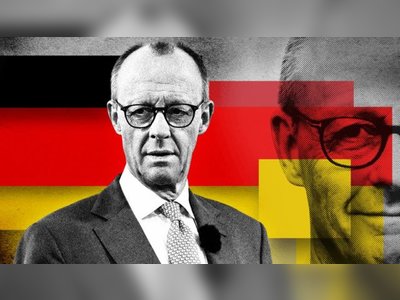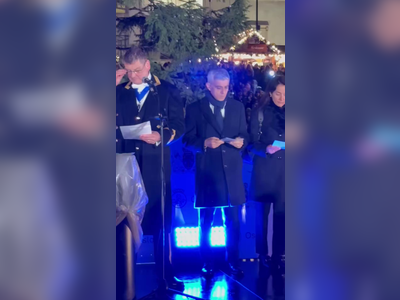
'You don't mess with Gran': the private life of Elizabeth II
“You don’t mess with Gran,” Prince Harry told a television interviewer in 2012, the year of his grandmother’s diamond jubilee. In that one sentence he conjured up the backbone that had carried Queen Elizabeth II through one of the longest reigns in British history, presiding over a family dynasty which had its difficult moments but by the end of her time on the throne had established itself in the public affection. In terms of length of reign and longevity, she had equalled even her great-great-grandmother, Queen Victoria, whose own diamond jubilee in 1897 had represented the last great blaze of imperial splendour.
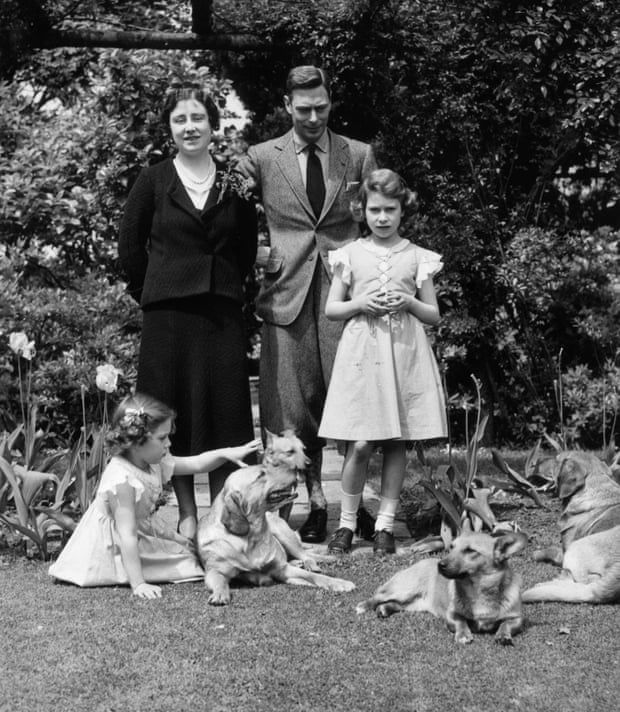 The Royal family with their dogs in the grounds of the Royal Lodge, Windsor.
The Royal family with their dogs in the grounds of the Royal Lodge, Windsor.
How had Elizabeth transformed herself from the shy girl who was only 10 when she became heir presumptive after her uncle Edward VIII had abdicated on 10 December 1936, making way for her nervous, stammering father, King George VI? “Lillibet”, as she was known in the family, had been brought up with her younger sister, Margaret Rose, in a typical upper-class nursery on the top floor of a five-storey Mayfair house, No 145 Piccadilly (destroyed by a bomb in the second world war).
The house swarmed with servants: butler, under-butler, two footmen, a housekeeper, a cook, a steward’s room boy, three kitchen maids, a dresser for her mother, a valet for her father, a night watchman, an odd-job man, plus an RAF orderly and a boy scout to man the telephone. Elizabeth and Margaret had a nurse, “Allah Knight”, and a young Scots nursery maid called Margaret MacDonald, known as “Bobo”, who would remain one of the people closest to Elizabeth for more than 60 years.
She was a tidy, self-contained girl; her toys carefully arranged in glass-fronted cabinets, toy ponies in a passage outside. Winston Churchill, who first met her at Balmoral in September 1928 when she was two and a half, was impressed by qualities beyond her tidiness: “[She] is a character,” he told his wife. “She has an air of authority and reflectiveness astonishing in an infant.” Her doting father compared Elizabeth’s poise with the gliding dignity of her great-great-grandmother: “From the first moment of talking,” he told the writer Osbert Sitwell, “she showed so much character that it was impossible not to wonder that history would not repeat itself.”
 Princess Margaret, Queen Mary, Princess Elizabeth and the Duchess Of York watch the Trooping The Colour in 1935.
Princess Margaret, Queen Mary, Princess Elizabeth and the Duchess Of York watch the Trooping The Colour in 1935.
Tidy, reflective and authoritative, the young Elizabeth already understood the monarchy at close quarters. In 1935, she and Margaret, identically dressed in pink, had ridden in their grandfather’s silver jubilee procession, and seen the ecstatic reaction of the crowds to their simple, unassuming sovereign. Her grandmother, Queen Mary, chief apostle of the British monarchy and guardian of the royal flame, ensured that the children’s education should include royal history and the geography of the British empire, and took them on weekly cultural expeditions, either to a museum or to the Tower of London and the Royal Mint. “Is arithmetic more valuable than history to them?” she asked their governess, Marion Crawford (nicknamed “Crawfie” by the princesses). “They will never do their own household books.” Or, “Shouldn’t they get a more intellectual game than Racing Demon?”
More importantly, perhaps, for Elizabeth’s development as a grounded human being was her close, happy family life – “Us Four”, as her father liked to describe them – organised by her tough, clever, charming mother, who deftly presented their image as such to the world. For Elizabeth, the crucial ingredient was romance with her handsome third cousin, Prince Philip of Greece. She met and fell in love with Philip in July 1939 when she was 13 and he 18. After the second world war ended, they were married in the gloom of austerity Britain, “a flash of colour on the hard road we have to travel”, as Churchill put it.
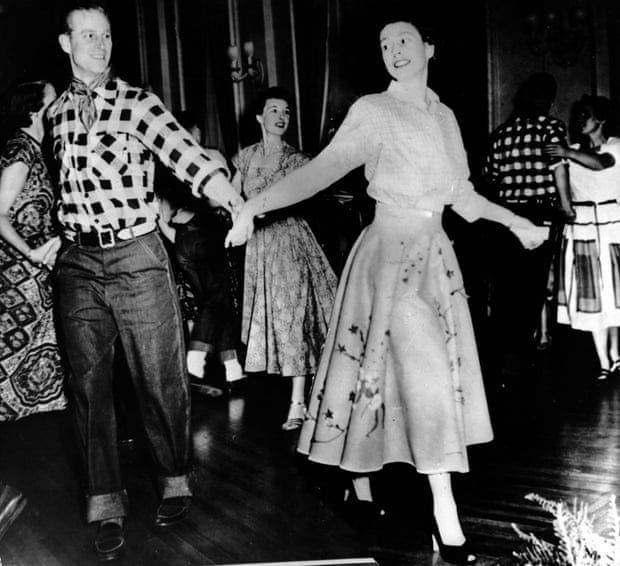 The Duke of Edinburgh dances with his wife, Princess Elizabeth, at a square dance held in their honour in Ottawa, October 1951.
The Duke of Edinburgh dances with his wife, Princess Elizabeth, at a square dance held in their honour in Ottawa, October 1951.
Her father’s courtiers looked down on him as a penniless foreigner who had not been to the right school (Gordonstoun as opposed to Eton). “They were bloody to him,” one of his cousins said, condemning him as “rough, uneducated and probably unfaithful”. Elizabeth was unfazed by their opposition; she loved him and was determined that his should be the guiding spirit in their married life. Philip was obliged to give up a promising naval career (he had had a heroic war) for his role as consort, walking two paces behind his wife and sitting at a lower level on occasions such as the state opening of parliament.
When their first child, Prince Charles, was born in 1948, he was not allowed to take his father’s family name of Mountbatten. “I’m nothing but a bloody amoeba,” a frustrated Philip stormed. After she became Queen on her father’s death on 6 February 1952, Elizabeth ensured that Philip took the important family decisions, including sending Charles to Gordonstoun, which he loathed.
They shared a love of the countryside and country sports. As a child, Elizabeth told Crawfie that when she grew up she would marry a farmer “and have lots of cows, horses, dogs and children” (note the order of importance). An enduring image of her in later life was on horseback, dressed in jodhpurs and jacket, with a 1950s silk headscarf on her head. She became an expert on breeding and training of horses and dogs, accompanying Philip out shooting and “picking up” the dead birds.
Her real passion was racing, inspired by her grandfather, who used to take her to visit his horses at Sandringham. Later she had her own stud. The only time she was seen expressing wild enthusiasm was at the races, jumping out of her seat, arms raised, fists clenched, a broad smile on her face.
 The Queen watches her horse Sign Manual win the Dreweatts Handicap Stakes at Newbury racecourse in 2013.
The Queen watches her horse Sign Manual win the Dreweatts Handicap Stakes at Newbury racecourse in 2013.
No intellectual, her evening study after a day spent on public engagements and reading state papers would be her form and stud books. On the morning of her coronation, just before her departure from Buckingham Palace to Westminster Abbey, one of her ladies-in-waiting asked if everything was all right, thinking the Queen might be apprehensive about the ceremony. Her Majesty replied that everything was fine, her trainer had just telephoned to say that her horse Aureole had gone very well in his last workout. At her audiences with Churchill, her first prime minister, more time would probably be spent discussing their mutual interest in racing than on the state of the nation.
The Queen might not have enjoyed literature, but she was intensely interested in politics and world affairs. “She liked to know who was up and who down,” wrote James Callaghan, prime minister in the late 70s. More seriously, in her long reign she met US presidents from Harry Truman to Joe Biden, UK prime ministers from Churchill to Boris Johnson and Liz Truss, popes from Pius XII to Francis, and heads of government – particularly from Commonwealth countries – with whom she had private one-to-one meetings.
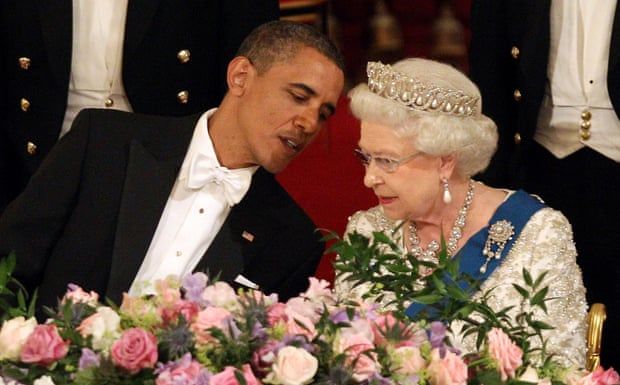 The then US president, Barack Obama, talks to Queen Elizabeth II during a state banquet at Buckingham Palace, 2011.
The then US president, Barack Obama, talks to Queen Elizabeth II during a state banquet at Buckingham Palace, 2011.
Ever since her 21st birthday in Capetown, when she had dedicated herself to the service of the Commonwealth, she had been particularly interested in Africa. “The Queen was sympathetic to the black cause in Rhodesia and southern Africa,” Lee Kuan Yew, senior minister of Singapore, said. It was a cause, however, which did not always appeal to British leaders, such as Edward Heath and Margaret Thatcher. Indeed, she did not visit South Africa again under the apartheid regime and only returned 48 years later, in March 1995, when she was greeted with great warmth by Nelson Mandela and crowds holding up placards saying “Welcome Back!”
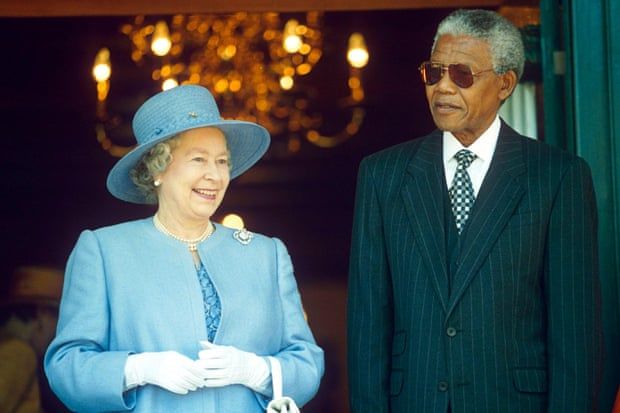 Queen Elizabeth II with Nelson Mandela on a tour of South Africa in 1995
Queen Elizabeth II with Nelson Mandela on a tour of South Africa in 1995
The Queen liked to laugh, one of her friends told me. She had a quick sense of humour and was an excellent mimic, a trait inherited from her mother. David Owen, foreign secretary in the Callaghan government, described how on the royal yacht Britannia when the last guest went, the Queen would kick off her shoes, tuck her feet under her skirts on the sofa and talk about the people who had been there that evening in a vivacious way. “Her face lights up and she becomes really attractive,” he said, “so you realise how much is kept under control.”
Susan Crosland, wife of Tony, Owen’s predecessor as foreign secretary, described as “positively cosy” the three days she and her husband spent on Britannia in 1976 sailing from Bermuda to Philadelphia for the bicentenary of the signing of the Declaration of Independence. There was “great affection between Elizabeth and her two ladies-in-waiting … intimacy and little jokes”. She also noted the complete naturalness of her behaviour in front of the Croslands. On one occasion when Philip was sounding off about something, the Queen told him off “quite sharply”: “Oh Philip, do shut up. You don’t know what you’re talking about.”
After a night’s rolling over huge waves in a force nine gale off Bermuda, the Queen joked about the previous evening: “I’ve never seen so many grey and grim faces round a dinner table”. Then she paused to poke fun at Philip, an admiral of the fleet: “Philip was not at all well” – another pause – “I’m glad to say.” She giggled.
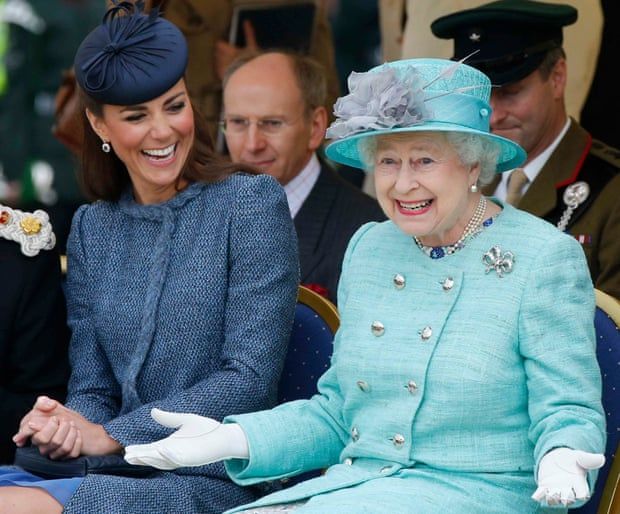 Catherine, Duchess of Cambridge laughs as
Queen Elizabeth gestures while they watch part of a children’s sports
event during a visit to Vernon Park in Nottingham, 2012.
Catherine, Duchess of Cambridge laughs as
Queen Elizabeth gestures while they watch part of a children’s sports
event during a visit to Vernon Park in Nottingham, 2012.
Belying her serene appearance, Elizabeth had a sharp temper, which she kept under control; once, when two footmen were larking about in the dining room at Sandringham she was heard giving them a right royal telling off which shocked them into silence. Otherwise she evoked loyalty and affection among her staff, particularly her ladies-in-waiting and the women who were closest to her every day, her “dressers” – first Macdonald, and latterly Angela Kelly, who had considerable influence over what the Queen wore and how she looked. Plans for public appearances, state visits and official trips abroad were made months in advance; hats, dresses, shoes, and pieces from the fabulous jewellery collection were all coordinated. Fittings, often attended by one or two corgis, could last half a day. According to Kelly, the Queen’s instincts were usually correct and she rarely changed her mind.
Apart from money spent on racing, Elizabeth was the least extravagant of monarchs. Economy was ingrained during the wartime years at Windsor when black lines were painted on the baths so that only a few specified inches of hot water could be used, and the boilers were frequently turned off. In later life, she was reported as going round Buckingham Palace switching off lights, and she was photographed in rooms heated only by distinctly unregal, old-fashioned, two-bar electric fires.
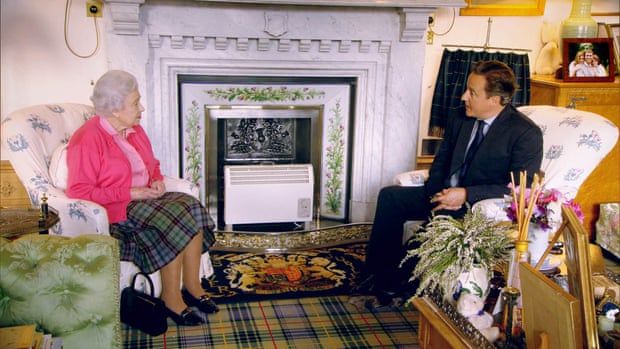 The Queen at her audience with then-Prime Minister David Cameron in her private sitting room at Balmoral
The Queen at her audience with then-Prime Minister David Cameron in her private sitting room at Balmoral
In the mid-1990s, the Queen suffered the worst publicity of her reign as a result of the misbehaviour of her children and in-laws in public and in private. The collapsing marriage of the Prince and Princess of Wales was played out via publicity wars in the media, going from bad to worse until the Queen ordered the couple to divorce in December 1995. She could be criticised for not stepping in earlier; “the Queen didn’t like confrontation”, one friend said.
Occupied with her job and frequently absent on duty, she had perhaps not been there enough for her children as they grew up and, like everyone else except her husband, they were in awe of her. Apart from the shame she felt their behaviour had brought on the monarchy, divorce was abhorrent to her from her Christian family upbringing. Her maternal grandmother, Nina Cecilia Strathmore, had instilled the strong Christian principles she had inherited from her clergyman father into her family. Attendance at chapel, when the ladies of the household wore crocheted lace caps, had been an important part of life at Glamis. These principles had been passed down by the Queen Mother to her daughters; when Margaret renounced the idea of marriage to the divorced Gp Capt Peter Townsend in 1955, she cited her belief in the principles of marriage under the church as her motivation.
There is no doubt that Prince Philip was a key figure in Elizabeth’s public and private life. He was the only person in the world who would dare to tell her she was wrong; he would bellow at her in an outburst of temper when irritated by her preoccupation with the corgis, who would swirl around her at teatime yapping to be fed. Yet, as he wrote to his mother-in-law, Queen Elizabeth, while on honeymoon:
“Lilibet is the only thing in this world which is absolutely real to me, and my ambition is to weld the two of us into a new combined existence that will not only be able to withstand the shocks directed at us, but will also have a positive existence for the good.”
In return, some 60 years later, the Queen publicly expressed her feelings about her husband in an address to parliament in the year of her diamond jubilee: “Prince Philip is, I believe, well known for declining compliments of any kind,” she said in a wry reference to her husband’s irascible public persona. “But throughout he has been a constant strength and guide.”

